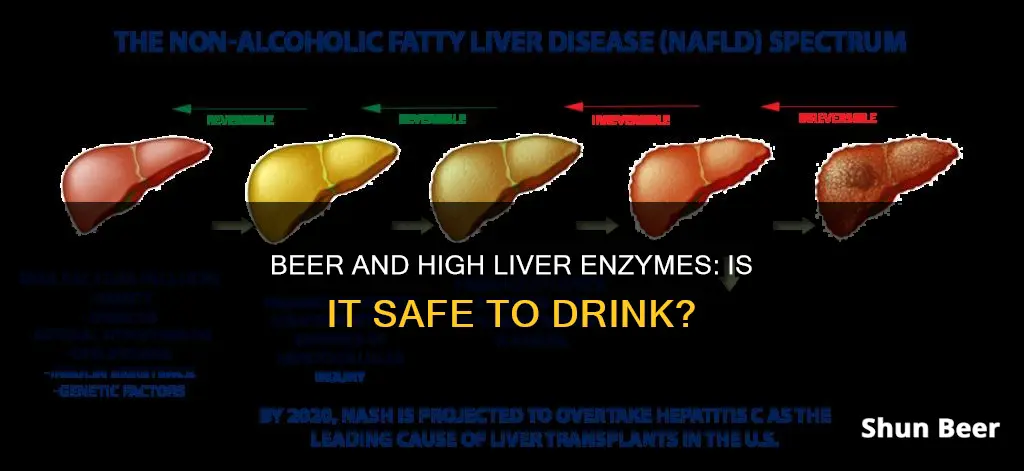
Alcohol is a poison, and when consumed in excess, it can cause the liver to react. The liver's job is to break down alcohol, and if you drink more than it can process, it can become badly damaged. Alcohol-induced liver problems can lead to inflammation and cell damage, and even a single night of binge drinking can have a negative impact.
Binge drinking is defined as consuming five or more drinks within two hours for men and four or more drinks in two hours for women. Binge drinking produces fatty liver tissue and triggers the early stages of inflammation, which are indicators of alcohol-induced liver disease. It also increases the levels of alcohol-metabolising enzymes, which can cause oxidative damage and other forms of harm to the liver.
Elevated liver enzymes are a sign of liver inflammation or damage, and alcohol consumption is a major cause of elevated liver enzymes. Therefore, if you have elevated liver enzymes, you should avoid drinking alcohol, especially if the cause is unclear.
| Characteristics | Values |
|---|---|
| Can beer elevate liver enzymes? | Yes |
| What is alcoholic liver disease? | Alcohol-associated liver disease is common, but it is preventable. There are three types: steatotic (fatty) liver, acute hepatitis, and cirrhosis. |
| What causes alcoholic liver disease? | Alcohol-associated liver disease is caused by heavy alcohol use. The liver breaks down alcohol, and if you drink more than it can process, it can become badly damaged. |
| What is unhealthy or heavy alcohol use? | For men, consuming 5 or more drinks on any day or 15 or more drinks per week. For women, consuming 4 or more drinks on any day or 8 or more drinks per week. |
| What are the symptoms of alcoholic liver disease? | Steatotic (fatty) liver often has no symptoms. Acute hepatitis and cirrhosis share these symptoms: abdominal discomfort or pain, jaundice, portal hypertension, gastrointestinal bleeding, ascites, and increased infections. |
| How is alcoholic liver disease treated? | The aim of treatment is to restore some or all normal function to the liver. It is important to stop consuming alcohol, and in some cases, change your diet. |
| Can the liver repair itself after years of drinking? | This depends on the severity of the damage. Fatty liver and alcoholic hepatitis are often reversible, but cirrhosis cannot be cured. |
| Can you drink alcohol with elevated liver enzymes? | No, since elevated liver enzymes are a sign of liver inflammation or damage. |
What You'll Learn

Binge drinking and liver damage
Binge drinking can quickly lead to liver damage. A study by researchers at the University of California, San Francisco (UCSF) found that seven weeks of binge drinking in mice caused fatty liver tissue, inflammation, and changes in liver enzymes, all of which are indicators of early-stage liver disease. Binge drinking increases the levels of alcohol-metabolizing enzymes, which can cause oxidative damage and other forms of harm to the liver.
Liver disease is on the rise among young people, and doctors are regularly diagnosing young patients with cirrhosis, or late-stage liver scarring. Binge drinking is particularly common among younger adults aged 18-34 and is defined as consuming four or more drinks for women and five or more drinks for men within a couple of hours. This pattern of drinking increases the blood alcohol concentration to at least 0.08 g/dL and is associated with increased violence and accidents.
The amount of alcohol consumed heavily influences the development of alcoholic liver disease (ALD). An intake of 400 g of ethanol per week, for example, strongly increases the risk of developing cirrhosis. Binge drinking is a risk factor for ALD, and public health measures aimed at reducing binge drinking among young people should be implemented to prevent this deadly condition.
Alcohol causes fat to accumulate in the liver, which can lead to scarring, inflammation, cirrhosis, fatty liver disease, and liver cancer. Binge drinking can lead to acute alcoholic hepatitis, causing severe liver inflammation without any scarring. Excess weight and obesity compound the liver damage caused by drinking, and obesity is usually a primary factor in non-alcoholic liver disease.
The liver has a unique ability to heal itself and replace damaged tissue, so early diagnosis and treatment of liver disease are crucial. Lifestyle changes and regular CT scans to monitor the disease are important. However, if left untreated, cirrhosis can develop into an irreversible condition, increasing the risk of liver cancer.
Underground Beer Coolers: Do They Keep Drinks Chilled?
You may want to see also

Alcoholic liver disease
Steatotic liver is the most common alcohol-induced liver problem. It is caused by a build-up of fat inside the liver cells, leading to an enlarged liver. This can happen to anyone who consumes a lot of alcohol, and it rarely causes any symptoms. However, it is an important warning sign that a person is drinking at a harmful level.
Acute hepatitis is an acute inflammation of the liver, causing liver cell death and often followed by permanent scarring. Alcohol-associated hepatitis is linked to long-term unhealthy alcohol use, but it can also occur from binge drinking.
Cirrhosis is the destruction of normal liver tissue, leaving scar tissue in its place. The liver may stop working correctly at this stage. Cirrhosis is generally not reversible, but stopping drinking alcohol immediately can prevent further damage and increase life expectancy.
The effects of alcohol on the liver depend on the amount consumed and the duration of drinking. Alcoholic liver disease is most common in people between 40 and 50 years old, with men being more likely to develop the disease. However, women may develop the disease after less exposure to alcohol than men. Some people may also have an inherited risk.
The liver is very resilient and capable of regenerating itself. However, prolonged alcohol misuse over many years can reduce its ability to regenerate, resulting in serious and permanent liver damage. Each time the liver filters alcohol, some liver cells die, and while the liver can develop new cells, excessive drinking kills them faster than they can be regenerated.
The symptoms of alcoholic liver disease vary depending on its severity and can include poor appetite, weight loss, and small, red spider-like blood vessels on the skin. As the disease progresses, symptoms may include fluid buildup in the legs and abdomen, jaundice, redness on the palms, and easy bruising. ARLD is often diagnosed during tests for other conditions or when the liver has already sustained advanced damage.
The most important part of treating alcoholic liver disease is to stop drinking alcohol completely. With complete alcohol avoidance, the liver can often heal some of the damage caused by alcohol. Dietary changes may also be recommended, and in severe cases, a liver transplant may be required. Participating in an alcohol use disorder treatment program can help achieve the goal of abstinence and improve the likelihood of favourable outcomes.
Beer and Penicillin: Safe Mix or Health Risk?
You may want to see also

Reversibility of liver damage
Liver damage can be reversed, but the extent of reversibility depends on the stage of the damage. The liver is the only organ in the body that can repair itself by creating new tissue instead of scar tissue. However, if the liver is still under attack from a virus, drug, or alcohol, scar tissue may develop, leading to cirrhosis.
Liver damage occurs in different stages, starting with inflammation, called hepatitis, which can be caused by viruses, metabolic problems, alcohol consumption, or autoimmune conditions. This inflammation can lead to fibrosis, where the liver cells produce collagen, making them stiffer, and eventually leading to scar tissue formation. Fibrosis can be reversed if addressed early. The final stage is cirrhosis, which is severe scarring of the liver. Even at this stage, fixing the underlying condition can reverse cirrhosis and prevent complications like liver failure.
To reverse liver damage, it is crucial to remove the cause of the damage. For example, if alcohol consumption is the cause, stopping drinking is essential. Lifestyle changes, such as maintaining a healthy weight, eating a balanced diet, reducing highly processed foods, and managing conditions like high blood pressure and cholesterol, can also help. Regular medical monitoring is vital to ensure the liver damage isn't worsening and to manage any other conditions that may increase the risk of cirrhosis.
Beer and Tetanus Shots: What You Need to Know
You may want to see also

Liver inflammation and damage
Liver inflammation, or hepatitis, is a condition where the liver is damaged and unable to carry out its essential functions. These functions include clearing toxins from the blood, making bile and certain hormones, and controlling fat storage and cholesterol production and release.
The liver is a highly immunologically complex organ, responsible for the production of acute-phase proteins, complement components, cytokines, and chemokines. It contains large, diverse populations of resident immune cells. In a healthy liver, metabolic and tissue remodelling functions require elements of inflammation. This inflammation, in combination with regular exposure to dietary and microbial products, creates the potential for excessive immune activation.
The most common cause of liver inflammation is viral hepatitis, which can be spread through ingestion of contaminated food or water, contact with infected blood, or sexual contact with an infected person. Viral hepatitis can also be passed from a pregnant person to their baby during childbirth. Other causes of liver inflammation include alcohol use disorder, exposure to toxins or certain drugs, autoimmune disorders, and prolonged blockage of bile flow.
Symptoms of liver inflammation can include abdominal pain or bloating, dark urine and light stool, nausea with or without vomiting, and yellowing of the skin and eyes (jaundice). In some cases, liver inflammation can be life-threatening, with symptoms such as abdominal swelling, bloody or black vomit, changes in mental status or behaviour, and severe abdominal pain.
The treatment for liver inflammation depends on the type of hepatitis. This may include drinking plenty of fluids, stopping alcohol use, and discontinuing medications that may damage the liver or increase the risk of bleeding. Antiviral drugs may also be used to treat some forms of viral hepatitis.
Left untreated, liver inflammation can lead to fibrosis, or scarring of the liver, which can progress to end-stage liver disease and liver failure.
Beer After Laparoscopic Gastrectomy: What You Should Know
You may want to see also

Liver failure
Alcohol-related liver disease (ARLD) is caused by liver damage due to excessive alcohol consumption over time. The liver breaks down alcohol, and this process releases toxins that damage liver cells. Even without getting drunk, repeated alcohol ingestion beyond what the liver can process will result in liver damage.
There are three stages of ARLD:
Alcoholic Fatty Liver Disease
This is the first stage, where fat starts to accumulate around the liver. It can be cured by abstaining from alcohol.
Acute Alcoholic Hepatitis
Alcohol abuse causes inflammation of the liver in this stage. The outcome depends on the severity of the damage. Treatment can reverse mild cases, while severe cases can lead to liver failure.
Alcoholic Cirrhosis
This is the most severe form of ARLD, where the liver is extensively scarred, causing it to shrink and harden. Cirrhosis is usually irreversible and can lead to liver failure.
ARLD is a significant concern, with approximately 8-10% of Americans drinking heavily. Of those, 10-15% will develop ARLD. Heavy drinking is defined as more than eight alcoholic beverages per week for women and more than 15 for men.
The risk factors for ARLD include a family history of the disease, frequent heavy drinking, poor nutrition, and binge drinking. Binge drinking is defined as consuming five or more drinks within two hours for men and four or more drinks in two hours for women.
The symptoms of ARLD vary depending on the stage of the disease. Early symptoms include poor appetite, weight loss, and small, red spider-like blood vessels on the skin. As the disease progresses, symptoms may include fluid buildup in the legs and abdomen, jaundice, enlarged breasts in men, and confusion or problems with thinking.
If left untreated, ARLD can lead to serious complications, including permanent liver scarring, liver failure, and even death. Therefore, it is crucial to address the problem early on and make necessary lifestyle changes, such as stopping alcohol consumption and improving nutrition.
Booster and Beer: Is It Safe to Drink Alcohol?
You may want to see also
Frequently asked questions
No, you should not drink beer if you have high liver enzymes. Since elevated liver enzymes are a sign of liver inflammation or damage, you should avoid alcohol—especially if the cause is not yet clear.
Liver enzymes are substances the liver releases in response to damage or inflammation. The most common enzymes checked for liver function are alanine transaminase (ALT) and aspartate transaminase (AST). Elevated levels of these enzymes are often used as indicators of liver damage.
High liver enzymes can be caused by alcohol consumption. Alcohol is broken down by the liver, and if you drink more than it can process, it can become badly damaged.
High liver enzymes can lead to inflammation and damaged cells in the liver. This can cause a range of health issues, including abdominal discomfort or pain, jaundice, portal hypertension, gastrointestinal bleeding, ascites, and increased infections.







